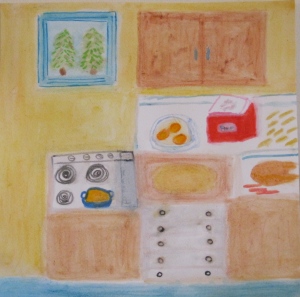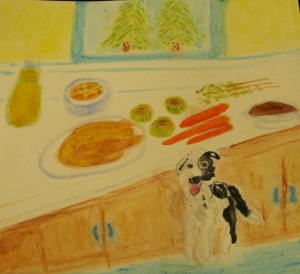My Grandma Carroll, who contributed the rolls to so many of our holiday dinners, was famous for her chicken and noodles — it was probably the best dish she made and the one everybody wanted the recipe for — but she didn’t want anyone to best her at her star food. When my mother asked her how she made them, she said, “Oh, you just take an egg and a cup of flour.” She neglected to mention the other two eggs or extra egg yolks she always added. So Mom went home and made them and they were impossibly dry.
The next time we went over to Grandma’s house, my Mom said, “Mother, do you only put one egg in your noodles?”
Grandma turned her head to the side and started giggling.
“Well, if you have another egg…,” she said.
My mother finally figured out that the correct ratio was three eggs to one cup of flour, or an egg and as many extra egg yolks as you had from some other cooking project.
You add the flour (seasoned with 1/4 tsp of salt and 1/2 tsp of paprika) to your eggs or egg and yolks and knead it for awhile until it is spongy. Then you roll it out as thinly as possible on a floured cloth.
Now you have a choice. You can cut your noodles and have them “soft,” or you can let the rolled out sheet of dough dry out for a day, depending on how much advance planning you have done. Our family prefers noodles that have dried for a day — that’s what Grandma made.
I watched Mom make these yesterday. She cut the dough in half before she rolled it out, so, one cup of flour and three eggs make two sheets of noodles. Then she set them on a tea towel to dry with a sheet of paper over them. Several hours later she replaced the paper with another tea towel. Grandma used to hang sheets of noodles over the top of her swinging door and I have seen Mom hang them in ingenious ways in the past, but she doesn’t do that anymore — now she dries them flat (If you hang your noodles they may dry better because they’ll get better air circulation). This time we let them dry overnight.
Whenever you cut them, roll each sheet of dough up like a jelly roll and cut them in thin strips: remember that noodles expand in the broth that you cook them in, so cut them thin.
Grandma most often made chicken and noodles cooked in chicken stock: she would cook a chicken in water, bones and all, remove the chicken, take some of the meat off the bones, boil down the cooking stock and cook her noodles in it. But if she had turkey leftovers, she would boil up the turkey carcass, neck and giblets for stock, reserving some turkey meat, and cook her noodles in that. When we make stock, we add in ends of carrots and celery for extra flavor. We strain the stock and remove some of the fat.
Mom says it is important to leave some fat in the stock so that you will not have a flat flavor. I say you have to have some salt in the stock to avoid the same flat flavor — if the noodles taste flat I either add salt at the table, or eat them with Tabasco sauce. Mom says that Grandma also added some butter to her stock before adding the noodles. For best results, heat the strained stock to a full rolling boil, drop noodles into it a few at a time and cook the noodles in the turkey (or chicken) stock until they are soft (from fifteen minutes to half an hour. At this point, season with salt and pepper to taste, add 1 Tbsp of butter and then add your reserved meat until it is just heated through in the noodles.
These noodles improve over the next few days: you might consider them to be second generation leftovers.

